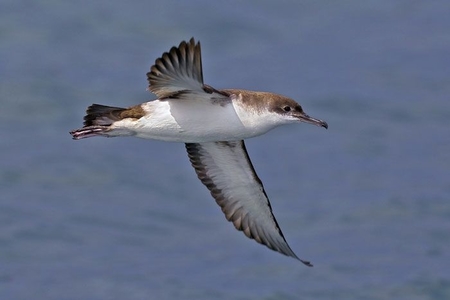Puffinus yelkouan
Family: Procellariidae
Length: 34 – 39 cm
Wingspan: 78 – 90 cm
Weight: 330 – 480 g

Identification
Appearance: medium-sized seabird with highly contrasted belly and back, fine beak and marked angle with the head.
Distinguishing characteristics: more contrasted than Balearic Shearwater.
Flight: flight beaten and glided, swings sideways, close to the surface.
Sound: silent at sea but colonies are noisy at night, with raucous cackling calls.
Ecology and habitat
Nest: breeds on offshore islands and coastal cliffs and nests in burrows which are only visited at night to avoid predation.
Diet: feeds on small pelagic preys such as anchovy, sardine, sprat and squids; also planktonic crustaceans and discards from fishing ships.
Behaviour at sea: gregarious, can be seen in large numbers from boats or headlands.
* This map indicates coastal nesting sites in the Mediterranean and adjacent Seas.
Distribution and movement
Breeding: in the eastern and central Mediterranean, from southern France and eastern Tunisia (France, Italy, Malta, Algeria, Tunisia, Croatia, Albania, and Greece); possibly in Bulgaria and Turkey.
One mixed breeding colony of both Yelkouan and Balearic Shearwaters has been reported on Minorca.
Wintering: migrates mostly to the Eastern Mediterranean (including the N. Adriatic Sea) and to the Black Sea during the post-breeding period whereas some individuals stay relatively close to their breeding areas in the Mediterranean Sea.
Phenology: arrival to the nesting site in early November for birds looking for a mate; later for couples already formed. Laying: between March and May; one egg per year. Incubation: about 50 days. Hatchings: as early as May. Both parents feed the chick until it takes to flight between June-July, 60 to 68 days after hatching.
Conservation
Global population estimate: 21,000 – 36,000 pairs;
46,000 – 92,000 individuals, but up to 90,000 individuals have been recorded migrating through the Bosporus.
Threats: fishery bycatch, introduced predators (rats, cats), mortality induced by urban lights, hunting and egg-harvesting, marine pollution.
Protection level: Barcelona Convention : Annex II; Bern Convention : Annex II; Birds Directive : Annex I; IUCN Red List: Vulnerable.
Some key references
Austin RE et al. (2019) Patterns of at-sea behaviour at a hybrid zone between two threatened seabirds. Scientific reports, 9(1), 1-13.
Bourgeois K (2012) Etat des connaissances et de conservation actualisé des populations nicheuses des petites îles Méditerranée. Initiative PIM, 22p.
Derhé M (2012) Population assessment for the Yelkouan Shearwater Puffinus yelkouan. In: BirdLife International (ed.), Methodology for Bird Species Recovery Planning in the European Union. Final Report to the European Commission. BirdLife Intl. for the European Commission, Cambridge, UK.
Gaudard C (compiler) (2018) Single International Species Action Plan for the Yelkouan Shearwater Puffinus yelkouan. Project LIFE 14 PRE/UK/000002. Coordinated Efforts for International Species Recovery EuroSAP. LPO/BirdLife France. Rochefort. 43p.
Oppel S., Raine A.F., Borg J.J., Raine H., Bonnaud E., Bourgeois K., Breton A.R. (2011) Is the Yelkouan Shearwater Puffinus yelkouan threatened by low adult survival probabilities? Biol. Conserv. 144: 2255–2263.
Péron C., Grémillet D., Prudor A., Pettex E., Saraux C., Soriano-Redondo A., Authier M., Fort J. 2013. Importance of coastal Marine Protected Areas for the conservation of pelagic seabirds: The case of Vulnerable yelkouan shearwaters in the Mediterranean Sea. Biol. Conserv. 168: 210–221.
Pérez-Ortega M., İsfendiyaroğlu S. 2017. Predicting foraging hotspots for Yelkouan Shearwater in the Black Sea.Deep Sea Research Part II: Topical Studies in Oceanography 141: 237-247.
Raine A.F., Borg J.J., Raine H., Phillips R.A. 2013. Migration strategies of the Yelkouan shearwater Puffinus yelkouan. J. Ornithol. 154: 411–422.
